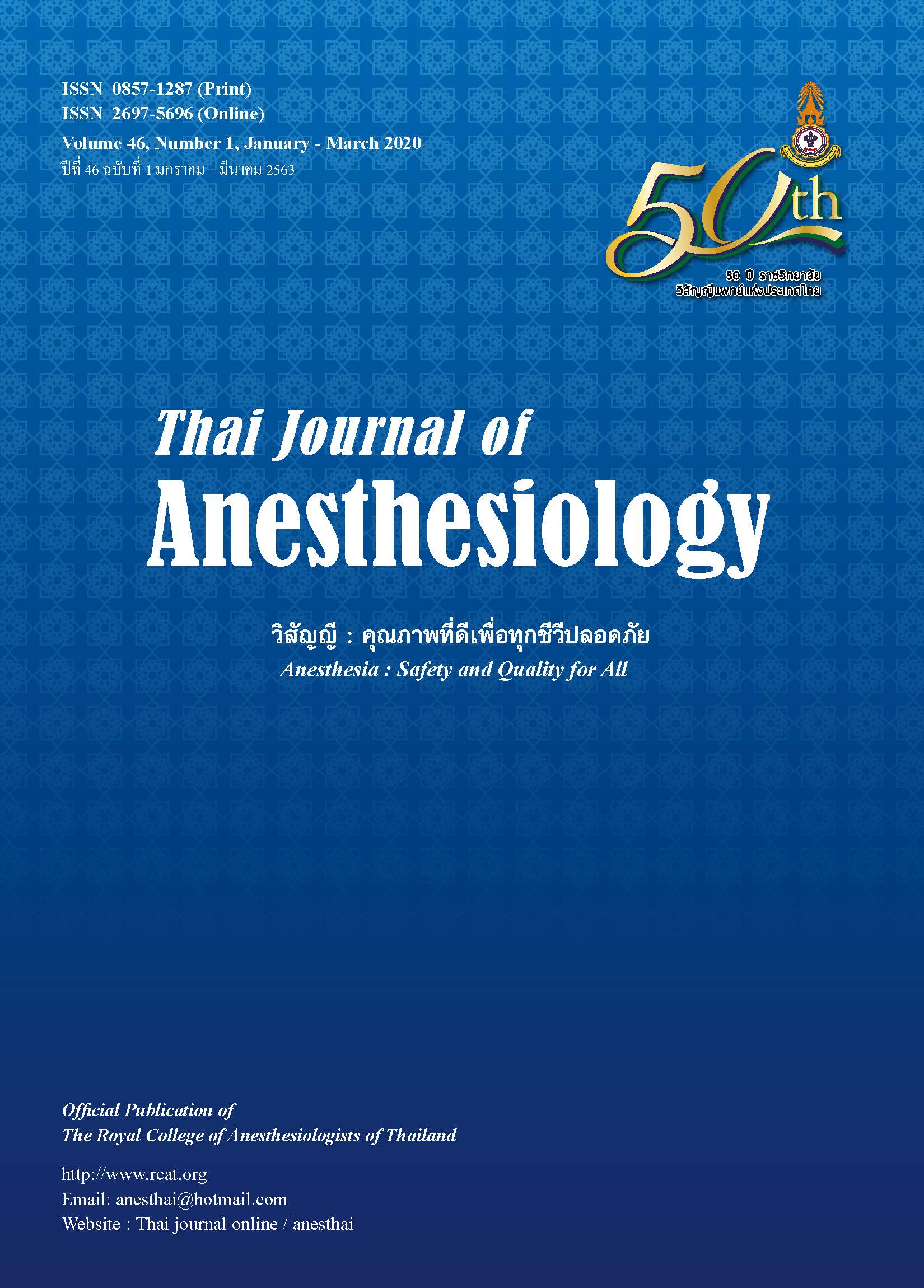Complications after Open Heart Surgery at Suratthani Hospital
Main Article Content
Abstract
Background: Although cardiac surgery has been
improved in both surgical and anesthesia technique. It is
still categorized as the major surgery with high risk for
postoperative complications. Suratthani Hospital has
performed open heart surgery for many years but still lacks
data on postoperative complications.
Objectives: To explore the postoperative complications
after open heart surgery at Suratthani Hospital and identify
risk factors.
Methods: The electronic database of the hospital between
October 2017 and September 2018 were reviewed
retrospectively. The collected data were preoperative
status, intraoperative events and postoperative major
complications.
Results: One hundred and forty patients were enrolled.
The overall postoperative complication was 68.6%. They
were categorized as: cardiovascular system 54.3%;
respiratory system 29.3%; neurological system 1.4%;
renal system 25.7%; infection 5%; and reoperation 7.9%.
The mortality rate was 7.9%. The risk factors for postoperative
complications were preoperative hypertension (OR 2.896,
95%CI 1.386-6.052, p=0.004) and arrhythmia (OR 3.151,
95%CI 1.018-9.750, p=0.041), cardiopulmonary bypass
time >150 min (OR 3.476, 95%CI 1.515-7.975, p=0.003),
and aortic cross-clamping time >90 min (OR 3.516, 95%CI
1.437-8.600, p=0.005)
Conclusions: The incidence of postoperative complications
in open heart surgery was 68.6% with mortality rate of
7.9%. The identified risk factors were preoperative
hypertension, arrhythmia, cardiopulmonary bypass time
>150 min and aortic cross-clamping time >90 min.
Article Details
References
Mortality and complications of coronary artery bypass
grafting in Rio de Janeiro, from 1999 to 2003. Arq Bras
Cardiol 2010;95(3):303-12.
2. Ball L, Costantino F, Pelosi P. Postoperative complications
of patients undergoing cardiac surgery. Curr Opin Crit Care
2016;22(4):386-92.
3. Braile DM, de Godoy MF. History of heart surgery in the world.
Rev Bras Cir Cardiovasc 2012;27(1):125-34.
4. Crawford TC, Magruder JT, Grimm JC, et al. Complications
After Cardiac Operations: All Are Not Created Equal. Ann
Thorac Surg 2017;103(1):32-40.
5. Edwards FH, Ferraris VA, Kurlansky PA, et al. Failure to
Rescue Rates After Coronary Artery Bypass Grafting: An
Analysis From The Society of Thoracic Surgeons Adult Cardiac
Surgery Database. Ann Thorac Surg 2016;102(2):458-64.
6. Reddy HG, Shih T, Englesbe MJ, et al. Analyzing “failure to
rescue”: is this an opportunity for outcome improvement in
cardiac surgery? Ann Thorac Surg 2013;95(6):1976-81.
7. Camp SL, Stamou SC, Stiegel RM, et al. Can timing of
tracheal extubation predict improved outcomes after cardiac
surgery? HSR Proc Intensive Care Cardiovasc Anesth
2009;1(2):39-47.
8. Hawkes CA, Dhileepan S, Foxcroft D. Early extubation for
adult cardiac surgical patients. Cochrane Database Syst Rev
2003(4):CD003587.
9. Moulton MJ, Creswell LL, Mackey ME, Cox JL, Rosenbloom
M. Reexploration for bleeding is a risk factor for adverse
outcomes after cardiac operations. J Thorac Cardiovasc
Surg 1996;111(5):1037-46.
10. Sellman M, Intonti MA, Ivert T. Reoperations for bleeding
after coronary artery bypass procedures during 25 years.
Eur J Cardiothorac Surg 1997;11(3):521-7.
11. LaPar DJ, Isbell JM, Mulloy DP, et al. Planned cardiac
reexploration in the intensive care unit is a safe procedure.
Ann Thorac Surg 2014;98(5):1645-51.
12. Mazzeffi M, Zivot J, Buchman T, Halkos M. In-hospital
mortality after cardiac surgery: patient characteristics, timing,
and association with postoperative length of intensive care
unit and hospital stay. Ann Thorac Surg 2014;97(4):1220-5.
13. Shahian DM , O’Brien SM, Filardo G, et al. The Society of
Thoracic Surgeons 2008 cardiac surgery risk models: part
1--coronary artery bypass grafting surgery. Ann Thorac Surg
2009;88(1 Suppl):S2-22.
14. O’Brien SM, Shahian DM, Filardo G, et al. The Society of
Thoracic Surgeons 2008 cardiac surgery risk models: part
2-isolated valve surgery. Ann Thorac Surg 2009;88(1 Suppl):
S23-42.
15. Lomivorotov VV, Efremov SM, Pokushalov EA, Karaskov AM.
New-Onset Atrial Fibrillation After Cardiac Surgery:
Pathophysiology, Prophylaxis, and Treatment. J Cardiothorac
Vasc Anesth 2016;30(1):200-16.
16. Premaratne S, Premaratne ID, Fernando ND, Williams L,
Hasaniya NW. Atrial fibrillation and flutter following coronary
artery bypass graft surgery: A retrospective study and
review. JRSM Cardiovasc Dis 2016;5:2048004016634149.
17. Peretto G, Durante A, Limite LR, Cianflone D. Postoperative
arrhythmias after cardiac surgery: incidence, risk factors, and
therapeutic management. Cardiol Res Pract 2014;2014:615987.
18. Ali-Hassan-Sayegh S, Mirhosseini SJ, Haddad F, et al.
Protective effects of corticosteroids in coronary artery bypass
graft surgery alone or combined with valvular surgery: an
updated and comprehensive meta-analysis and systematic
review. Interact Cardiovasc Thorac Surg 2015;20(6):825-36.
19. Cappabianca G, Rotunno C, de Luca Tupputi Schinosa L,
Ranieri VM, Paparella D. Protective effects of steroids in
cardiac surgery: a meta-analysis of randomized double-blind
trials. J Cardiothorac Vasc Anesth 2011;25(1):156-65.
20. Whitlock RP, Devereaux PJ, Teoh KH, et al. Methylprednisolone
in patients undergoing cardiopulmonary bypass (SIRS): a randomised,
double-blind, placebo-controlled trial. Lancet
2015;386(10000):1243-53.
21. Gallart L, Canet J. Post-operative pulmonary complications:
Understanding definitions and risk assessment. Best Pract
Res Clin Anaesthesiol 2015;29(3):315-30.
22. Mazo V, Sabate S, Canet J, et al. Prospective external
validation of a predictive score for postoperative pulmonary
complications. Anesthesiology 2014;121(2):219-31.
23. Jammer I, Wickboldt N, Sander M, et al. Standards for
definitions and use of outcome measures for clinical
effectiveness research in perioperative medicine: European
Perioperative Clinical Outcome (EPCO) definitions: a statement
from the ESA-ESICM joint taskforce on perioperative outcome
measures. Eur J Anaesthesiol 2015;32(2):88-105.


